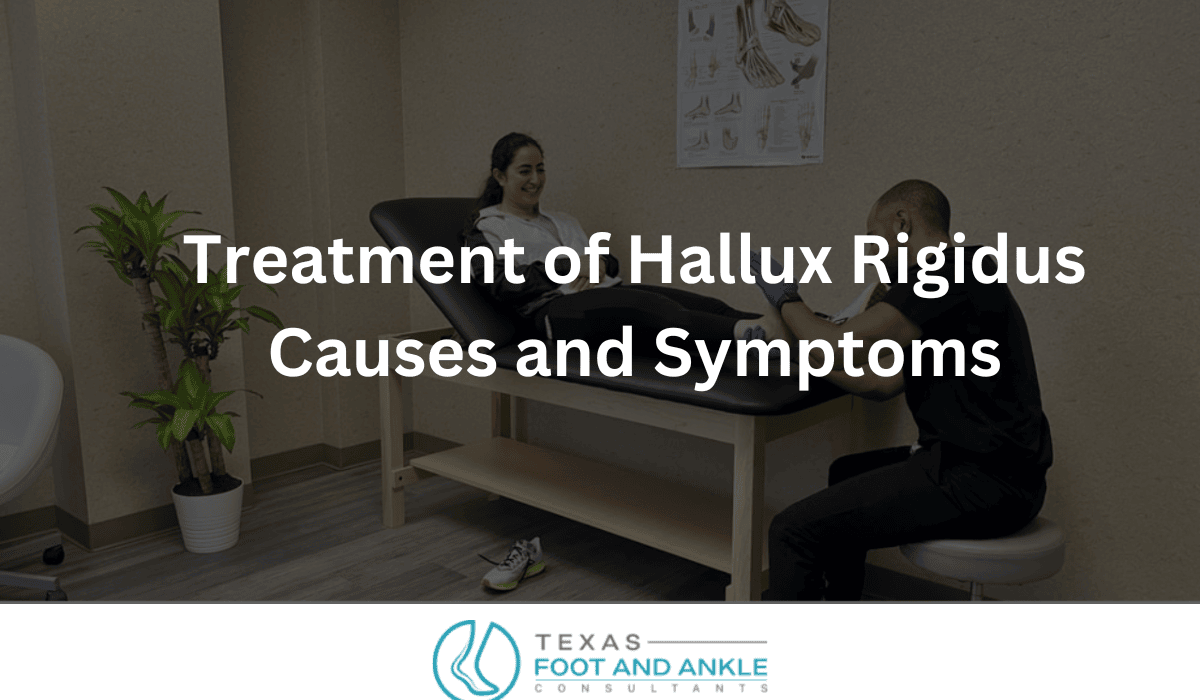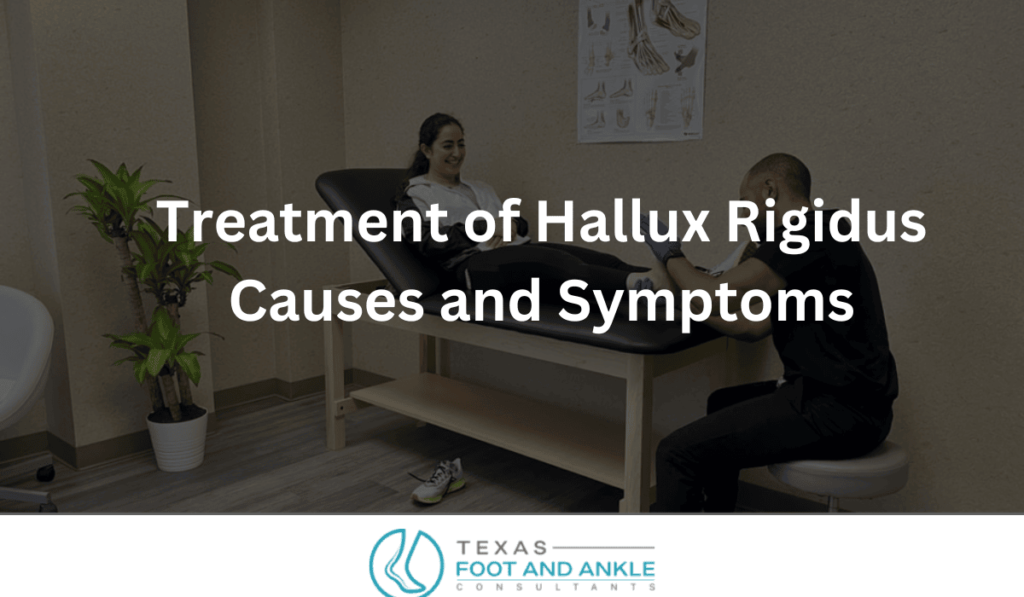Treatment of Hallux Rigidus

Hallux rigidus is a condition affecting the joint at the base of the big toe. It is a form of degenerative arthritis that can cause pain, stiffness, and limited motion in the joint. The condition typically develops over time and can affect anyone, but it is more common in adults over 30 years old. Common symptoms include pain and stiffness in the big toe joint, swelling around the joint, difficulty in wearing shoes, and pain during physical activities.
Texas Foot and Ankle Consultants is dedicated to the treatment and recovery of all your Foot and Ankle conditions. Our physicians are committed to providing the latest and best treatments for your ailments, ensuring that you receive outstanding clinical care, research, and education. Dr. Delpak, board qualified through The American Board of Foot and Ankle Surgery in both Foot Surgery and Reconstructive Rearfoot and Ankle Surgery, leads our team.
Diagnosing Hallux Rigidus
Diagnosing hallux rigidus usually involves a physical examination of the affected foot and a review of your medical history. Your podiatrist may also order X-rays or other imaging tests to assess the extent of joint damage and rule out other conditions. Early diagnosis is key to managing symptoms and preventing further joint damage.
Non-Surgical Treatment Options
1. Medications and Injections
For mild to moderate cases of hallux rigidus, over-the-counter pain relievers such as ibuprofen or naproxen may be recommended to reduce pain and inflammation. These medications can be effective in managing symptoms on a day-to-day basis. In cases where pain relief is not sufficient, corticosteroid injections directly into the joint can provide temporary relief of symptoms. These injections are aimed at reducing inflammation and can offer relief for several months, allowing patients to resume normal activities without discomfort.
2. Orthotics and Footwear Modifications
Custom orthotic devices, such as arch supports or shoe inserts, can play a crucial role in the management of hallux rigidus by helping redistribute pressure away from the affected joint. These devices are tailored to the individual’s foot anatomy and can provide support and cushioning where it’s most needed. Additionally, wearing shoes with a wide toe box and stiff sole can also help reduce pressure and pain on the joint. This modification allows for more room and comfort around the toe area, preventing further irritation and discomfort during daily activities.
3. Physical Therapy and Exercises
Physical therapy exercises are beneficial in the treatment of hallux rigidus as they help improve the range of motion in the big toe joint and strengthen the muscles surrounding the joint. Toe stretches and range-of-motion exercises, prescribed by a physical therapist, can help maintain joint flexibility and reduce stiffness. These exercises are designed to improve the function of the big toe joint, allowing for better mobility and reducing pain. Additionally, physical therapists may recommend specific strengthening exercises to build up the muscles that support the joint, which can help stabilize the toe and reduce the progression of the condition.
Surgical Treatment Options
1. Cheilectomy
A cheilectomy is a surgical procedure aimed at treating hallux rigidus by removing bone spurs and reshaping the joint to increase the range of motion. This procedure is often recommended for patients with mild to moderate hallux rigidus who have not found relief with conservative treatments. During a cheilectomy, the surgeon removes the bone spurs and smoothens the surface of the joint to reduce pain and improve joint movement. This can help alleviate symptoms such as stiffness and difficulty walking. Cheilectomy is typically an outpatient procedure, allowing patients to return home the same day, and recovery time varies depending on the individual but often involves physical therapy to restore strength and flexibility to the joint.
2. Arthrodesis (Fusion)
Arthrodesis, also known as fusion surgery, is a procedure that involves fusing the bones of the big toe joint together to eliminate painful motion. This surgical option is typically recommended for patients with severe hallux rigidus who have not responded to conservative treatments. During arthrodesis, the damaged cartilage within the joint is removed, and the bones are then fused together using screws or other fixation devices. Over time, the bones grow together, creating one continuous bone and stabilizing the joint. Although arthrodesis eliminates motion in the big toe joint, it can significantly reduce pain and allow patients to return to normal activities without discomfort. Recovery from arthrodesis can take several months, and physical therapy may be recommended to regain strength and mobility in the foot.
3. Joint Replacement (Implant)
In some cases of severe hallux rigidus, a joint replacement implant may be used to replace the damaged joint with an artificial joint. This option is typically considered for younger, active patients who want to maintain joint motion. During a joint replacement procedure, the damaged cartilage and bone of the big toe joint are removed and replaced with an artificial implant made of metal and plastic components. This allows for smoother movement and reduced pain in the joint. Joint replacement surgery can provide significant relief for patients who have not responded to other treatments. Recovery from joint replacement surgery may take several months, and physical therapy is usually recommended to help regain strength and mobility in the foot.
Recovery and Rehabilitation
Recovery from surgery will depend on the type of procedure performed. Physical therapy and rehabilitation exercises are often recommended to regain strength and mobility in the foot. Most patients can expect to return to normal activities within a few months after surgery. For procedures like cheilectomy or joint replacement, recovery may involve wearing a protective boot or using crutches for a period of time to allow for healing. Physical therapy sessions will focus on restoring joint function, improving range of motion, and strengthening the muscles around the foot and ankle. Your healthcare provider will provide specific guidelines for post-operative care and rehabilitation tailored to your individual needs.
Prevention and Long-Term Management
Preventing hallux rigidus involves wearing appropriate footwear, maintaining a healthy weight, and avoiding activities that put excessive stress on the big toe joint. Long-term management may include periodic check-ups with your podiatrist and adjustments to treatment as needed.
If you’re experiencing symptoms of hallux rigidus, it’s essential to seek help from a qualified foot doctor. Contact Texas Foot and Ankle Consultants, your trusted foot doctor in Richardson, TX, for expert diagnosis and treatment options. Don’t let hallux rigidus limit your mobility and quality of life. Schedule an appointment today!


